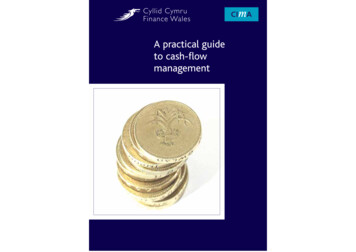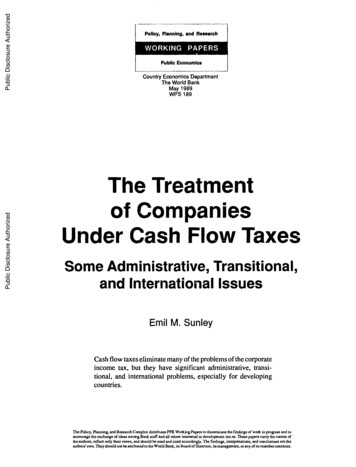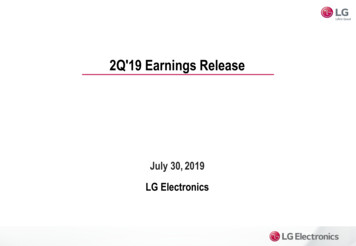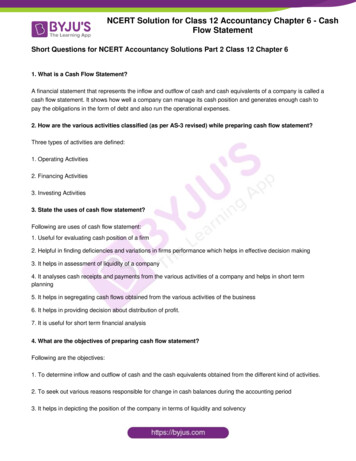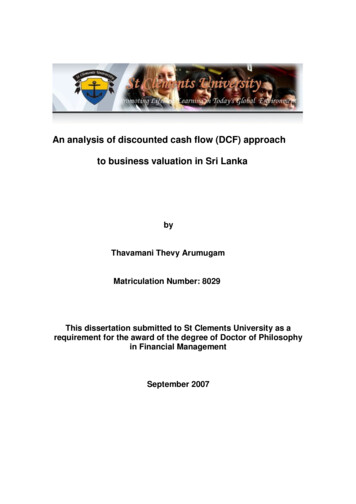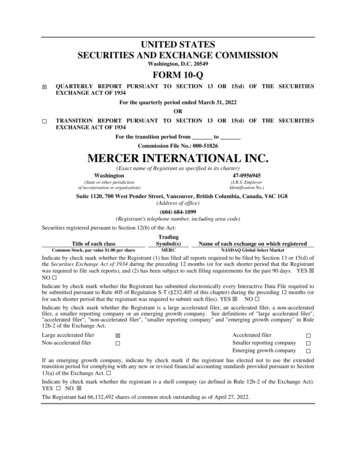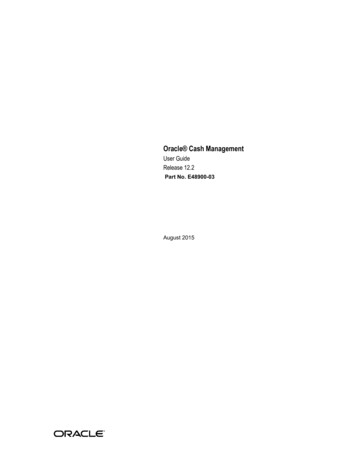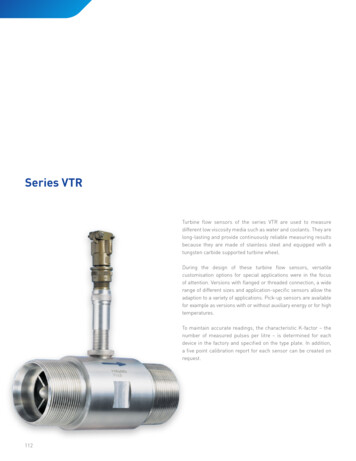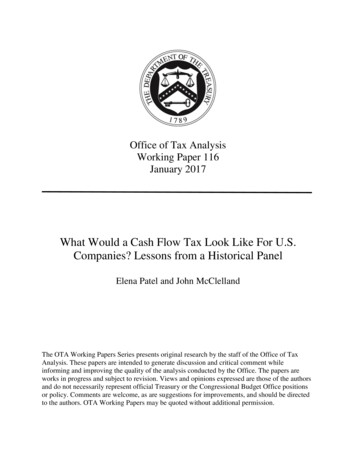
Transcription
Office of Tax AnalysisWorking Paper 116January 2017What Would a Cash Flow Tax Look Like For U.S.Companies? Lessons from a Historical PanelElena Patel and John McClellandThe OTA Working Papers Series presents original research by the staff of the Office of TaxAnalysis. These papers are intended to generate discussion and critical comment whileinforming and improving the quality of the analysis conducted by the Office. The papers areworks in progress and subject to revision. Views and opinions expressed are those of the authorsand do not necessarily represent official Treasury or the Congressional Budget Office positionsor policy. Comments are welcome, as are suggestions for improvements, and should be directedto the authors. OTA Working Papers may be quoted without additional permission.
WHAT WOULD A CASH FLOW TAX LOOK LIKE FOR U.S. COMPANIES?LESSONS FROM A HISTORICAL PANELJanuary 2017Elena Patel1 and John McClelland2In this article, Patel and McClelland present a prototype destination basis cash flow tax toreplace the existing corporate income tax. To gain some insight into the potential consequencesof the United States adopting a cash flow tax of this form the authors use a panel of tax returnsover the 2004-2013 period to compare and contrast an income tax base and a cash flow tax baseon a firm by firm basis. This simulation points out the similarity of the tax bases for most firmsbut that treatment of import and export activity is of disproportionate importance.Keywords: National Taxation, Public Economics, Public Finance, Revenue, Tax Data, BusinessTax, Tax System, Optimal Taxation, Consumption Tax.JEL Codes: H20, H21, H25, H321Elena Patel: Office of Tax Analysis, U.S. Department of the Treasury, Elena.Patel@treasury.gov.John McClelland: Tax Analysis, Congressional Budget Office, John.McClelland@cbo.gov. His contribution to thiswork occurred prior to his departure from the Office of Tax Analysis where he was previously employed.2The authors wish to thank Alan Auerbach, Curtis Carlson, Michael Devereux, Adam Looney, James Mackie, LauraPower, and Alan Viard for helpful comments and encouragement.2
IntroductionPolicy makers continue to struggle with determining the best template for reform or replacementof the corporate/business tax system in the United States. Desirable characteristics include: Simplicity Improved incentives for investment and growth Minimal distortions on business location incentivesNumerous modifications to the current income tax system have been proposed but none havebeen sufficiently appealing as to be adopted as of yet. This lack of consensus regarding an “easyfix” opens the door to much more fundamental changes.Reforms such as Toder and Viard (2016) or Grubert and Altshuler (2016) would maintain acorporate income tax at a significantly reduced rate of 15 percent and replace the lost revenuewith increased tax revenue from firm owners. An alternative path would maintain a tax onbusinesses (as opposed to shifting the statutory incidence to firm owners) but move from theexisting “income” tax base to a cash flow base. Discussion of the advantages of such a tax havea long history including in Treasury’s “Blueprints for Basic Tax Reform (1977), the 2005President’s Advisory Panel on Federal Tax Reform in the form of its “Growth and InvestmentTax Plan”, and more recently Auerbach’s “Modern Corporate Tax” (2010). In this paper, weattempt to extend that work by simulating the impact of replacing the current corporate taxsystem with a destination basis cash flow tax. To accomplish this goal we will specify manyoperational parameters; these choices are meant to be illustrative rather than declarative. Thehope is that by more fully specifying how a cash flow tax would work, we can identify thepressure points of such a system and advance the discussion of the strengths and weaknesses forthis type of reform relative to alternatives.In the simplest sense, a cash flow tax is exactly what the title implies: a tax that is levied on thecash entering the business less the cash leaving the business. By providing consumption taxtreatment to business income, the cash flow tax creates incentives typically attributed toconsumption taxes, such as increased incentives for investment, reduced distortions acrossdifferent types of investment, and no distortion across the financing of investment. In practice,this cash flow tax would look similar to the current corporate tax in that it would be administeredby levying a tax liability on each business on an annual basis.By choice this study contemplates a replacement of the corporate income tax while largelyleaving in place the current individual income tax. This is in part to facilitate comparisons withother business-only reforms, such as the Administration’s Framework for Business Tax Reform,proposals for a patent box, or a move to territorial taxation. Secondly this study is motivated bytax reform proposals, such as the X-tax3 and congressional outlines for business tax reform, bothof which rely on cash flow tax principles. There are reasons why a cash flow business tax pairedwith an individual income tax on wages and capital income might be sensible in the UnitedStates. For example, as reform options are considered in the current public discourse, there havebeen broad calls for reforms that would simultaneously spur growth and help address increasing3For additional information on the X tax, see Robert Carroll and Alan Viard, (2012), Progressive ConsumptionTaxation: The X Tax Revisited, AEI Press3
income inequality. In this case, the classical income tax system is viewed as being insufficientlysupportive of growth, and consumption tax based reforms are viewed as being incapable of beingsufficiently progressive, so a simpler and broader income tax or a consumption tax faces stronglyheld resistance. The combination of a business tax on cash flow and a progressive individualincome tax on wages and capital income might prove to be a path forward. The key insight isthat consumption can be taxed based on how it is financed rather than how it is spent.Consumption financed from corporate profits, windfall gains, good luck, or existing shareholderwealth can be subject to the business cash flow tax while consumption financed from sourceslike wages, Social Security, or cash in the bank can be exempted from the business cash flow tax.Moreover, consumption financed by corporate profits, luck, and wealth is far more concentratedthan income from other sources making it a very progressive source of tax revenues.We pair this insight with the fact that the current business income tax base, which is based onbusiness income, is increasingly comprised of income attributable to returns in excess of the riskfree return, such as returns from windfalls, monopolies, or rents (Power and Frerick 2016).Thus, consumption tax systems that provide expensing, relieving the burden of tax oninvestment, do not narrow the tax base as much as is typically feared. In addition, there isincreasing evidence that in the current tax system, multinational firms are able to use papertransactions to move some of the “excess” returns to low tax jurisdictions, leading us to believethat a well-designed cash flow tax base, which would access these shifted profits, could be evenlarger than the current U.S. income tax base might suggest. Taken together, this suggests thatincreased incentives could be provided for investment and growth by relieving the business taxburden on the normal return while maintaining a revenue base similar to the current corporateincome tax.Finally, we believe that a switch to a domestic cash flow tax on businesses could bolster theability of the tax system to address income inequality. Due to the relative immobility of labor inan open economy, a significant portion of the burden from a corporate income tax is believed tofall onto labor. Decomposing the corporate income tax base to the portions arising from the riskfree and “excess” returns helps to clarify the insight that a revenue neutral switch to a cash flowtax is likely to be a progressive change. This is due to the theoretical prediction that the tax onthe normal return in part burdens labor since capital is more internationally mobile than labor,whereas the tax on supernormal return is borne by shareholders.4 Setting aside whether onesystem has less excess burden than another, a move from the current corporate tax to a cash flowtax should be a more progressive way to raise a dollar of government revenue.This paper proceeds by describing the motivations for moving to a cash flow tax system. Wethen describe the specification of our prototype for a destination-based cash flow tax levied on Ccorporations in the United States. Given this specification, we describe the results andimplications of a microsimulation based on a historical panel of C corporations from 2004 to4See William Gentry (2007), A Review of the Evidence on the Incidence of the Corporate Income Tax, Departmentof the Treasury, Office of Tax Analysis Working Paper 101 for a review of the literature on the incidence of thecorporate tax and Julie-Anne Cronin, Emily Y. Lin, Laura Power, and Michael Cooper (2012), Distributing theCorporate Income Tax: Revised U.S. Treasury Methodology, Department of the Treasury, Office of Tax AnalysisTechnical Paper 5 for details on Treasury assumptions regarding the incidence of the corporate income tax.4
2013. Finally, we provide some concluding remarks on the relevance of this analysis in thebroader context of corporate tax reform.MotivationsHow to simplify the business tax system?The cash flow tax could provide significant simplification across two dimensions: first throughthe calculation of tax liability for each business, and second by reducing/eliminating the taxconsequences of the choice of organizational form, providing greater uniformity acrossbusinesses.The potential administrative simplifications to the firm can be motivated by thinking about whata business would need to track for a given transaction under an income tax versus a cash flowtax. For an input to production, the income tax relies on the business classifying what type ofpurchase was made. Was it an asset with a life sufficiently long that it would have to becapitalized? If so, how long of a life should be assigned to the asset? For a payment to afinancial intermediary, was this a repayment of principal or interest?Under a destination-based cash flow tax, the type of good or service purchased becomesirrelevant. The only determination that is needed is whether or not the purchase was from adomestic source. For a purely domestic firm, any accounting system that records the flow ofreceipts to the firm and the payments made by the firm would be sufficient to calculate the tax.In fact, by running transactions through a single bank account the vast majority of firms wouldbe able to report net cash flow using the same information that would be reported on associatedbank statements.This simplification in the determination of the tax base also simplifies the task of the taxadministrator, reducing the opportunities for many types of wasteful tax minimization strategies.For example, engaging in cross border transactions with related parties would no longer providethe opportunities to shift the tax base out of the United States.What income/profit to target?The shift to a business cash flow tax would be a tax on consumption as opposed to the currentbusiness tax, which is a hybrid of an income and a consumption tax. The cash flow tax wouldprovide for the immediate deduction of the costs of capital investment (often referred to asexpensing). This treatment of investment exempts the “normal” return on investment; in thisway, the business cash flow tax can be thought of as a tax on “super-normal” returns. Byremoving the disincentive to invest, a cash flow tax is typically considered to be growthenhancing relative to our current business income tax system. This change, by theoreticallynarrowing the tax base by excluding “normal” returns, would require a higher tax rate than a fullincome tax in order to be considered revenue neutral. However, how much narrower the tax basewould be with full expensing is an empirical question. Recent evidence shows that fornonfinancial C corporations, the fraction of the corporate income tax base attributable to the riskfree return has been gradually declining to approximately 25% (Power and Frerick 2016).Further, given the recent practice of providing “bonus” depreciation between 50% and 100% in5
all but three of the last fifteen years, a move to full expensing of investment represents a lesssignificant narrowing of the tax base compared to a current policy baseline.What about financial flows?The cash flow tax can, in theory, have two different flavors: the “R F” base, which includes both“real” and “financial” transactions, or the “R” base, which excludes financial transactions. Amove to the R F base, which is more comprehensive, has the potential for greater simplicity. Forexample, in a single rate system, loan payment and remittance exactly offset one another over thelife of the loan, negating the need to track these transactions. However, this simplicity comes atthe cost of the unintuitive include/deduction of principle payments as they flow to and from abusiness and the additional difficulty of drawing international borders around financial services,which are, perhaps more than any other service, only loosely associated with a particulargeographic location. For these and other reasons, most credit invoice value added taxes ignorefinancial transactions (and use the “R” base) ignoring the value added provided by financialservices and taxing financial intermediaries under a separate system. This coupled with the factthat lending to foreigners should be ignored in a destination basis cash flow tax suggests thatserious consideration should be given to only applying the “ F” treatment for transactionsbetween financial intermediaries and consumers, as suggested by Auerbach (2016).The tax treatment of multinational businesses?Globalization and the rise of multinational corporations has made clear the difficulties ofattempting to tax income differentially based on where it accrues.5 The current income taxsystem is susceptible to the stripping of income from high to low tax jurisdictions, particularly inthe case of intangible assets that are hard to price and increasingly important to multinationalbusinesses. Moreover, the necessity of transfer pricing under the income tax is costly to bothbusinesses and the tax administrator. While efforts such as the OECD’s Base Erosion and ProfitShifting Framework may aid the functioning of the current tax system, it cannot solve theinherent tension caused when jurisdictions attempt to tax income at different rates. In this case,the difficulty arises from the need to attribute profits to a particular location when in fact theproduction of a final good or service arose from a worldwide production chain. Rather thantrying to address this potentially unanswerable question, a destination-based cash flow taxfunctions by assessing tax where consumption occurs as opposed to where profit originates.The cash flow tax will still confront administrative difficulties, most notably with regard toservices. While it is relatively obvious where the consumption of tangible goods occurs, thelocation of services are more difficult. For example, providers may be in different countries thanthe customer in the case of virtual services. This is the same problem that the value added taxesemployed by our trading partners continue to confront. While there is no easy solution to thisproblem, a cash flow tax can take advantage of the guidelines developed by the OECD todetermine the appropriate jurisdiction to tax services.65For a description of the failings of the current tax system see The President’s Framework for Business Tax Reform:An Update (2016), ax-Reform-An-Update-04-04-2016.pdf6See the OECD’s International VAT/GST Guidelines (2015), at-gst-guidelines.pdf6
Specification of the Prototype Cash Flow TaxAs documented in a European Commission working paper (2015), there is relatively little realworld experience with a comprehensive business cash flow tax. Most prior experiences havebeen with narrow taxes targeted to particular industries. While the theoretical appeal of abusiness cash flow tax is well established, we fear that the lack of practical experience hascreated a bit of chicken and egg problem: there has been little serious consideration of a cashflow tax because one can’t look to an example of one, and without serious consideration we willnever observe this form of tax in practice. As an incremental step, this paper will use detailedadministrative tax data to simulate the impacts of a cash flow tax. The remainder of this paperfirst specifies an example of a business cash flow tax prototype for the United States and thendescribes the associated implications of this prototype for U.S. businesses and federal taxreceipts.In this prototype, we adopt an R base and treat financial intermediaries differently from otherbusinesses.7 Most businesses would exclude interest income, would not get a deduction forinterest paid, and would not include principle or repayment flows in the tax base. Financialfirms, however, would be taxed on the net flows to domestic customers not subject to the cashflow tax. When a cash flow tax is applied to all businesses and individuals are subject to anincome tax, this only results in special treatment for transactions between financial firms andconsumers. Given the regulated nature of most financial services provided to consumers, theadministration of the expanded tax base for financial firms should not be problematic.While the greatest simplification gains would occur if a business cash flow tax replaced both thecurrent corporate tax and the individual tax on active domestic business activity, we focus onlyon replacing the corporate income tax and ignore the question of the most appropriate treatmentof pass-through businesses. Under a cash flow tax, the domestic activity for all non-financial Ccorporations would be subject to tax at a single rate on the difference between receipts fromdomestic activity less expenses from domestic activity. Receipts would be the sum of domesticsales, and revenue from the sale of financial assets. Deductible expenses would be the sum ofpurchases of domestic intermediate goods, capital asset purchases, inventory investment,payments for domestic services (such as rent, advertising, etc.), state and local taxes (foreigntaxes would not be deductible), and wages/salaries/benefits. The tax base for financial firmswould include interest and principle repayment received and would deduct interest paid and theprinciple repayment paid to the extent that the counter party is a domestic taxpayer not subject tothe cash flow tax. If the choice is made to subject all business entities regardless oforganizational form to the cash flow tax, it would be equivalent to limit the “ F” treatment to theconsumer portion of the banking/lending operations and retain the R base cash flow tax for allother transactions.Relative to the current tax base, we ignore the following flows when calculating the cash flowtax base: active foreign source income, passive foreign source income and royalties, equity7As we will later describe, for this microsimulation we exclude financial intermediaries from our analysis.7
issuance, payments to equity holders, receipt of distributions as an equity holder, foreign sales,imports, charitable giving, and foreign taxes.Since all foreign transactions are ignored, it should be clear that this tax is limited toconsumption in the United States and thus does not have the distortionary location incentives ofthe current system. In contrast to a typical VAT, the border adjustments in this prototype areimplicit by making all imports non-deductible and exports non-taxable. Income earned overseascould be brought back without domestic tax consequences thus eliminating the distortions fromlockout that are created by the current system of a worldwide tax with deferral.As will be clear when we discuss the simulation results below, we abstract away from thequestion of which (if any) business credits might be allowable against a cash flow tax liabilityand what the treatment of losses should be. Instead, we focus on characterizing the size andvolatility of the tax base under the new regime. Since the cash flow tax would be administered ina fashion similar to the current corporate income tax, it would be possible to allow credits againstthis liability. In terms of designing a reformed tax, the major trade off is between the cash flowtax rate and the size of the credits in order to raise a given level of revenue. As for losses, thecurrent income tax system departs from the theoretically ideal treatment of providing refunds forlosses in order to treat economic profits and losses symmetrically. The existing asymmetrictreatment of providing loss carrybacks and carryforwards is typically justified as being acompromise between administrative ease and minimizing the potential for abuse.8 The sametrade-offs would also apply to a cash flow tax. In the results below, we describe how the lossesunder a cash flow tax compare to those under the current income tax when applying comparabletreatment for losses.The tax base described above is limited to domestic consumption by excluding from the tax baseany transactions with a foreign party. Purchases of production inputs from a foreign party wouldnot be deductible and sales to foreign purchasers would not be included in income. In practice,as long as the identity of the counterparty to each transaction is known, this approach toimplementing a destination based tax is administratively straightforward. Alternatively, adestination-based tax system could be implemented with explicit adjustments at the border forimports and exports in a manner that is similar to the treatment under a credit-invoice valueadded tax. Under this alternative, the government would rebate the tax on the value of exportedgoods and impose an equivalent tax on imported goods. As many commentators have pointedout, the two methods of administering the system are theoretically economically equivalent. Inour simulation, we have chosen the mechanism of implicit adjustments via excluding the foreigntransactions.9 The analysis of losses under this system will provide some insight as to whether inpractice netting the border adjustments is equivalent to explicit adjustments if the tax systemdoes not provide full refundability for losses.8For an analysis of the consequences of the current treatment of losses under the corporate income tax see MichaelCooper and Matthew Knittel (2010), The Implications of Tax Asymmetry for U.S. Corporations, National TaxJournal, 63:1, pp. 33-61.9For a discussion of the implications of this form of territorial adjustment see Alan Auerbach and Douglas HoltzEakin (2016), The Role of Border Adjustments in International rch/14344/)8
In a consumption tax, like a cash flow tax, a border adjustment is necessary to apply the same taxtreatment to domestic consumption of goods and services whether those goods are produceddomestically or imported and likewise, to equalize the tax-treatment of foreign consumption,whether produced abroad or from U.S. exports. Hence, those countries with VATs or certainexcise taxes have explicit border adjustments, In contrast, jurisdictions with retail sales taxes,such as U.S. states, include implicit border adjustments in the sense that this tax is applied toimported goods but not to exported goods. The experience around the world, as predicted byeconomic theory, has been that the border adjustment does not have trade effects. Instead, we’veseen that the real exchange rates move—after-tax domestic prices rise relative to foreign pricesby the amount of the tax. One implication of this is that while importers or retailers collect andremit the tax, they generally do not bear the economic incidence of the tax. That is important tokeep in mind when examining how the base of the cash flow tax expands with the borderadjustment.Simulating a Cash Flow TaxRecognizing that the costs of transitioning to a business cash flow tax may be large, we aim tocompare the cash flow tax to the current income tax system in a steady-state, behaviorally staticframework through a microsimulation. By abstracting away from the choices that must be madein order to administer the transition from one system to another, we are attempting to focus onthe underlying fundamental differences between the two systems. In particular, this analysisprovides insights into how the statutory burden of the cash flow tax may differ from the currentincome tax and the relative cyclicality of the two taxes. This analysis will also help tocharacterize the impact of a destination basis and the role of losses, both at a firm level and forthe corporate sector overall.The simulation that we construct is static in that we do not allow the firms to respond to thediffering incentives provided under a cash flow tax. This approach is helpful in identifying thepressure points that need to be carefully considered when designing the tax. Some simply reflectthe unwinding of current distortions of the existing income tax, such as the over reliance on debtfinancing of investment. Others are a direct result of the newly defined tax base, such as mergeractivity motivated by any asymmetric treatment of losses and/or the treatment of internationaltransactions.To motivate why the treatment of losses is important consider an elaboration on theFarmer/Miller/Baker example, which is often used to introduce credit invoice value added taxes.In this example the Farmer grows wheat from purchased seeds which is then sold to the Millerwho uses labor to produce flour which is then sold to the Baker who makes bread for retail sale.In Table 1 this traditional example is enriched by having the seeds imported by the Farmer andsome of the bread sold for export and some for domestic consumption. Since in this examplethere are no financial assets or capital, the income tax base and cash flow tax base before borderadjustments are identical. In this simple example, each of the three businesses have a positivetax base under both systems. When we introduce border adjustments that are netted in the taxbase the deduction for the imported seeds is not allowed and Farmer’s tax base is made larger.9
Meanwhile the exports by the Baker make the border adjusted tax base negative. If there is nomechanism to refund losses, we have a total tax base that is larger than domestic consumption.Further the Baker would have an incentive to merge with the Farmer and/or the Miller for purelytax driven reasons.Table 1FarmerMillerBakerTotalDomestic Purchases 0 400 700Foreign Purchases 200 0 0Purchases 200 400 700Labor 100 100 100 300Domestic Sales 400 700 700Foreign Sales 0 0 300Total Sales 400 700 1000Income Tax Base 100 200 200 500Cash Flow Before Border Adjustments 100 200 200 500Border Adjusted Cash Flow 300 200- 100 400This issue would be obscured by any aggregate analysis. In contrast, our microsimulationapproach provides us the opportunity to identify how common this theoretical problem might be.By comparing the current law income tax base to a cash flow tax base on a firm-by-firm basis,we can identify firms that are placed into a loss position by the border adjustments and as a resulthave incentives to respond to a potential tax reform depending on the treatment of losses and theadministration of the border adjustment.Microsimulation DetailsWe create a ten-year unbalanced historic panel by merging together the SOI corporate sample forconsolidated and unconsolidated subchapter C corporate tax returns from 2004 through 2013.10The SOI corporate sample reflects the initial filing of a tax return before adjustments whichinclude loss carrybacks. This panel includes 110,062 unique corporations with a median durationin the panel of 4 years. The sampling strategy for the SOI corporate sample includes the largestfirms every year and any corporation that is selected into the sample in a given year will beselected in again in the following year if filing under the same Employer Identification Number.Given this, it comes as no surprise that 99% of assets are present for a singular spell. In addition,19% of firms by counts and 84% of assets are present for the entirety of the 10 year period.For reasons previously described, we exclude the financial sector firms from our analysis. Inaddition, there are empirical reasons to exclude the financial sector from this particular analysis.In particular, our historical panel spans the Great Recession, which was an unusual time period10In particular, we keep only rely on a subset of 1120 Returns, excluding all pass-through corporations, 1120-S,1120-RIC, and 1120-REIT, which represent roughly 40% of the total sample, and those corporations that file an1120-L, 1120-F, and 1120-PC, which represent roughly 5% of the total sample.10
for all firms and particularly for financial institutions. Balance sheet items on the tax return thatmight be used to identify net financial transactions for these institutions are almost certainlyimpacted by the historically unique effects of quantitative easing and other countercyclical fiscaltools employed by the federal government and the Federal Reserve. We judged that theexperience during this period was so anomalous for this subset of firms that including thefinancial sector mi
The shift to a business cash flow tax would be a tax on consumption as opposed to the current business tax, which is a hybrid of an income and a consumption tax. The cash flow tax would provide for the immediate deduction of the costs of capital investment (often referred to as expensing).
